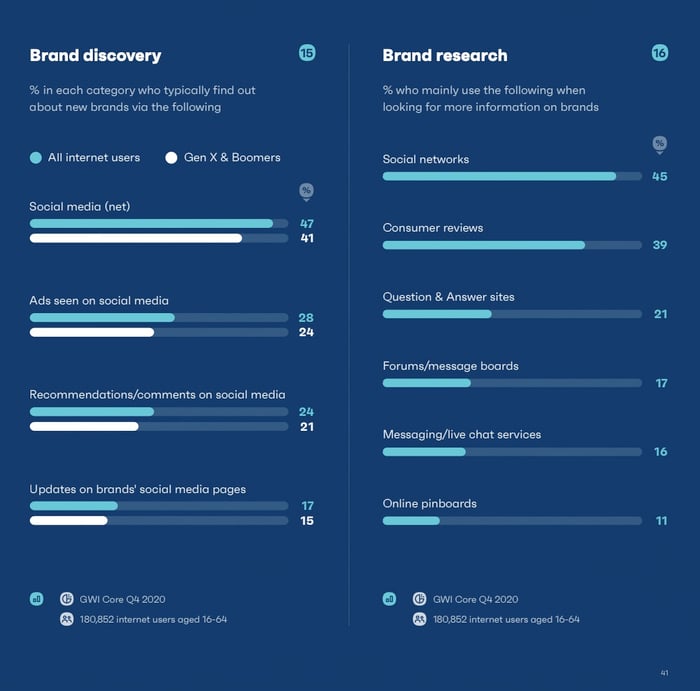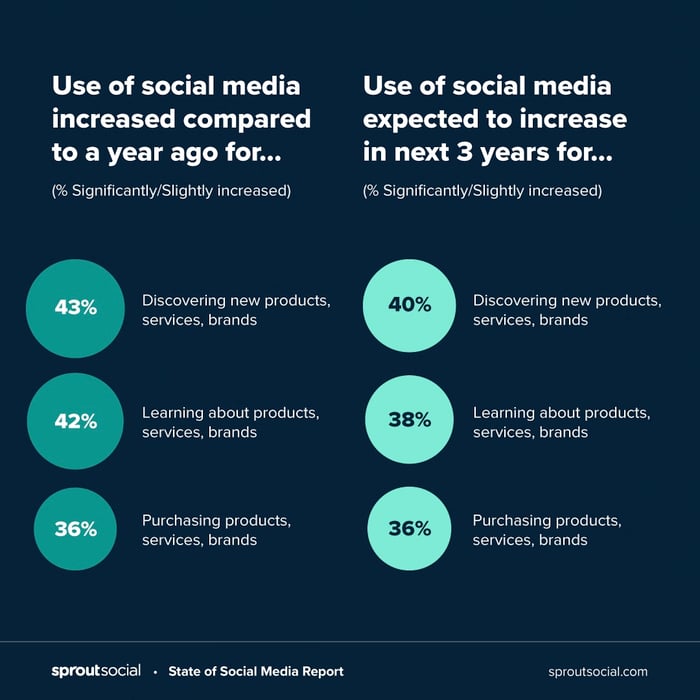State of Social Commerce
.jpg?width=1000&height=525&name=Instagram%20(1).jpg)
As for now it’s only a pilot available for a limited number of testers in the U.S. market, but their attempts to tap into social commerce next to already established players in the field like Facebook, Instagram, Snapchat, or TikTok confirm that social networks are no longer an insignificant revenue stream, but a very important channel where we’ll see more commerce happen.
The state of social commerce
Social commerce is an $89.4 billion market right now and projected to grow to $604.5 billion in the next seven years. To put that into perspective – it currently represents 2% of retail e-commerce sales worldwide. I might be a small fraction, but with changes in customer behavior accelerated by the global pandemic, social media will become more important in retail sales strategy.
As for now, social networks have been mostly utilized as a tool in brand discovery journeys. According to the recent report by Global Web Index on social media trends in 2021, 45% of internet users claim that social platforms are their main source of brand information and 47% use them for brand discovery. They also play an important role in peer-to-peer reviews.

Social media and messaging apps are already the number one tool for many. Imagine squeezing the funnel and keeping the customer in one place from the very beginning until the final purchase. Accelerated returns, lower churn rates, agile experiments, you name it. Add artificial intelligence and you will boost revenues and decrease operating costs.
David Stepaniuk, Retail Consultant, Netguru
Retailers have also noticed the growing potential of social media as a selling tool. Nearly a half of the respondents in The State of Social Media Investment Report claim that one of the top priorities for social media strategy will be selling - and the vast majority anticipate selling products or services via social media commerce platforms in the next three years.
Why social commerce
Social commerce allows retailers to directly promote and sell their products on social media. In response to the rising number of brands using social media for marketing purposes, the most popular networks provide companies with a wide range of tools to better target their potential customers. And there is a huge market to serve.
Facebook records 2.89 billion monthly active users, Instagram roughly one billion, Twitter 330 million, and Tiktok 689 million. Combined with the increasing amount of time spent on these platforms, there is a big opportunity for brands to offer products directly to customers where they hang out and where they’re the most engaged.
Interactions with branded content are also rising. More than 40% of social networkers claim that their use of social media sites for discovering and learning about new brands, products, and services increased compared to the last year and is expected to grow in the next three years. Giving users an option to complete purchases without leaving a single platform eliminates boundaries and provides them with a more streamlined experience.

In essence, social commerce is allowing for marketing and purchase ecosystems to align like they have before. It can contribute to frictionless experiences across the customer journey to drive home its power at the end.
Jinder Kang, Innovation Consultancy Lead at Netguru
The bottom line is to think about the whole customer journey across all platforms. Social media should not be a standalone channel detached from a general retail strategy. Consumers migrate between platforms searching for reviews, information on products, and the most suitable way to make a purchase once they’re ready. Having a consistent and seamless experience across all the channels is crucial to prevent dropouts at any stage of the funnel.
The right channel for social commerce
As more platforms are introducing or experimenting with social commerce features, now is the time when brands should seriously consider how to leverage the potential of these channels in creating and contributing towards revenues.
However, it is important to understand how users engage with your content on each of these platforms and what are their motivations and behaviors. Campaigns and offerings should naturally complement the discovery journey rather than disrupt the experience.
Pinterest for instance is widely used as a tool for finding home décor, food, and fashion inspiration. The buying intent in these cases is high – consumers look for ready designs and styles that can be incorporated into their homes or wardrobes. The ability to “shop the look” is an added value that will save them time spent on further research on ecommerce platforms or in traditional brick-and-mortar stores.
Instagram serves as an inspiration and brand discovery tool as well. However, there are an ever-increasing number of motivations why users are so engaged on the platform. It’s a source of entertainment, information, and a place for self-expression. Understanding the motives behind engaging with branded content is necessary to build a social commerce strategy.
TikTok
More popular among younger generations with nearly 50% of users aged below 30, TikTok is one of the world’s fastest-growing entertainment platforms. In the first half of 2020, the app was downloaded 616 million times by first-time users. It’s a huge market to serve, especially for brands trying to access Millennials or the Gen Z demographic. TikTok is also up-to-speed in the social commerce game. Next to some in-app features such as “Shop Now” buttons and the “Hashtag Challenge Plus,” they also partnered up with Shopify giving merchants access to selling and promotion tools directly from Shopify dashboard.
Snap
Snap, with up to 280 million daily active users, also has a big appetite for their slice of the social commerce market. In fact, as Yuval Ben-Itzhak, president of social media and digital marketing firm Socialbakers notes, Snap aims to “pivot from deriving revenue from its advertising platform to deriving revenue from its status as a social commerce platform”. What distinguishes Snapchat from other social networks is the augmented reality (AR) filter option driving engagement with branded content. The feature gives users more space to experience the products and try them on – something that is missing from online shopping.
Facebook still remains the world’s most popular social network, with users engaging with their inner circle, sharing content, and keeping up to date with news from around the world. However, the platform punishes the push for hard sales and prioritizes meaningful and engaging content. Understanding the algorithms behind it might seem like a mission impossible, but the key is to understand your target audience first, analyze how they interact with your content and only then invent ways to move the users down the sales funnel.
In GWI’s report on social media, Twitter’s vibe was described as exclusive. It's a very conversational platform where timeliness matters the most. Companies widely use it as a brand building tool and customer service channel. It’s an ideal channel to create deeper engagement around the topics that matter the most to the audience
Brands can leverage multiple ways to build conversation: polls, Twitter spaces, or Tweet chats. Because of Twitter’s chatty nature it might not be the most suitable channel to drive purchases. However, with a 42% drop in cost-per-ad engagement on Twitter and a 75% increase in ad engagement, it’s definitely worth seriously considering the platform as an additional revenue source.
Social commerce is here to stay
With the accelerated growth of ecommerce driven by the COVID-19 pandemic, brands will be seeking ways to engage with audiences online in more meaningful ways. It’s definitely not enough to run some ads and wait for orders to magically happen. Retailers need to think about where their potential customers are active and involve them in their content throughout the whole customer journey. A big part of that journey happens on social media.
By leveraging the latest tech innovations, retailers are capable of engaging their audiences at all stages of the sales funnel. Thanks to advancements in AR and VR technologies, consumers have the ability to try different looks from the comfort of their home, or simply play with filters for fun.
Artificial intelligence has also played an important role in complementing the buyer's journey. From smart product recommendations to size and fit calculators, ML-based algorithms allow brands to build a more personalized shopping experience with a tailored offering.
All these tech advancements within social media help brands increase engagement, grow the audience, provide entertainment and inspiration, and with more sales tools available they will fill the gaps in the last stages of the customer journey, providing a frictionless experience consumers expect. The bottom line is to holistically approach social media strategy with the end consumer at its center.








